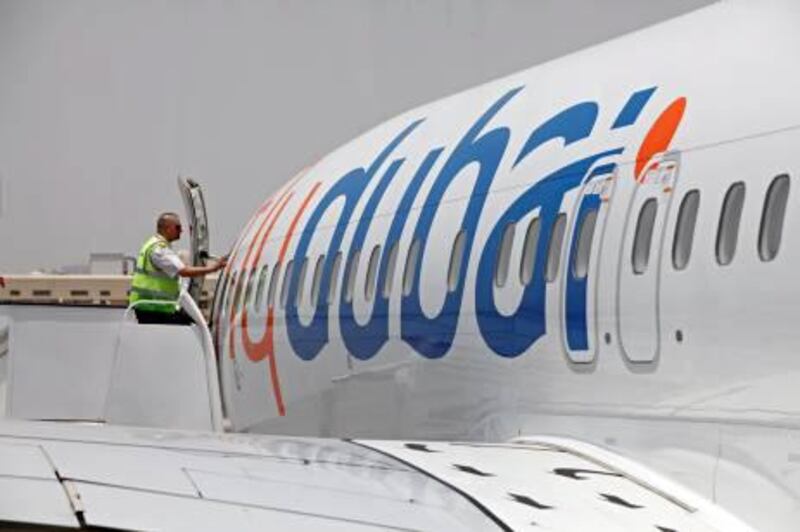On the face of it, the Arabian Gulf region's three main low-cost carriers appear to be doing rather well.
This week Air Arabia reported a 20 per cent rise in first-quarter net profit on the back of a 22 per cent jump in revenue.
Last month, flydubai launched its 57th new route since it started flying four years ago, thanks to rising profits, passenger numbers and market share.
Saudi Arabia's nasair also posted double-figure passenger growth rates for the first quarter. The carrier also said it was going public and that it was on target to be the first passenger operator out of Dubai World Central, Dubai's second airport and the world's first purpose-built aerotropolis.
All those carriers will be shopping for new aircraft this year, with announcements for new Boeing 737s and Airbus A320s widely being predicted for the Paris Airshow next month and the Dubai Airshow in November.
The rhetoric from their chief executives has been equally bullish.
"Air Arabia continues to witness significant growth in passenger numbers, and this demonstrates the popularity of the airline's value for money and excellent service," said Adel Ali, the airline's chief executive.
"Air Arabia will continue to set the standard for the low-cost travel segment, offering great fares to an ever-growing range of destinations."
Said the nasair chief executive Captain François Bouteiller: "The past year has been phenomenal as we saw the airline go from strength to strength. We look forward to sharing further growth indicators soon as this is the most exciting time for aviation in the Middle East."
He was speaking after his airline announced that it had recorded a 20 per cent increase in passenger traffic since the beginning of the year, compared to 2012, with flight numbers up 11 per cent.
And at the Arabian Travel Market in Dubai last week, the chief executive of flydubai Ghaith Al Ghaith had this to say: "We are pushing forward with our aggressive plan to continue to grow the airline and we are on track with that. This year we are getting six new aircraft, and we are launching 14 new destinations, seven already and seven more to come.
"We are focusing primarily on new markets where there is not proper connection to Dubai or there are not enough flights, as well as new markets that support tourism, trade and commerce both in Dubai and in the countries we fly to."
Indeed, few would argue the importance of the low cost carrier (LCC) market in the Middle East has grown steadily since Air Arabia first launched in 2003. But looked at longer term, just how successful has the industry been?
"Their penetration in the Middle East remains well down compared to many other regions internationally," said the international aviation consultancy, Capa Centre for Aviation in its 2012 industry survey. "LCCs in the region account for around 10 per cent of all regional seating capacity: 11.8 per cent of intra-Middle East capacity and 8 per cent of seats to/from the region.
"In Europe, LCCs account for 36 per cent of total intra-regional seating capacity. In Canada and the US, LCCs operate around 30 per cent of domestic capacity. In the Asia Pacific, LCCs operate a quarter of all intra-regional seats."
Where the local carriers have been successful is in adapting their version of the LCC to local demand; particularly migrant workers and VFR passengers (visiting friends and relatives), and in exploiting untapped markets. It is now common for the airlines to work with regional governments from central Asia, the Indian Ocean rim and Africa to develop and promote their local business tourism markets.
However, there have been significant drags on their market, said Capa.
"The past few years have seen a slowing of the explosive growth rate of LCCs in the Middle East. A number of factors, including high barriers to entry, protectionism in favour of state-owned carriers and the unrest to hit the region, have all contributed to this slow down.
"The 2010 and 2011 regional unrest was particularly unfavourable for LCCs, due to their higher exposure to local traffic and tourism traffic. "
The International Air Transport Association (Iata), which represents all the world's major airlines, said changes in the global industry also hit local LCC expansion, with many of the big, full-service Gulf carriers moving into regional routes, and making it difficult for LCCs to compete.
Also slowing LCC regional growth has been a lack of suitable secondary or smaller airports of the size normally used by budget airlines in Europe, North America and Asia- Pacific. While Air Arabia benefits from its base at Sharjah, flydubai has to operate out of Dubai International, one of the busiest hubs in the world.
Despite the negative factors however, Capa believes the best could be to come.
"With such low market penetration, the Middle East market is still ripe for exploitation by low-cost carriers," it said. "Regional governments are slowly opening up to the possibilities that LCCs offer for their local travel and tourism markets, with liberalisation under way in previously highly protected markets such as Saudi Arabia, Jordan and Lebanon.
"LCCs in the region have shown that they can be properly and profitably run, a fact that should trigger more LCC growth in the Middle East."





